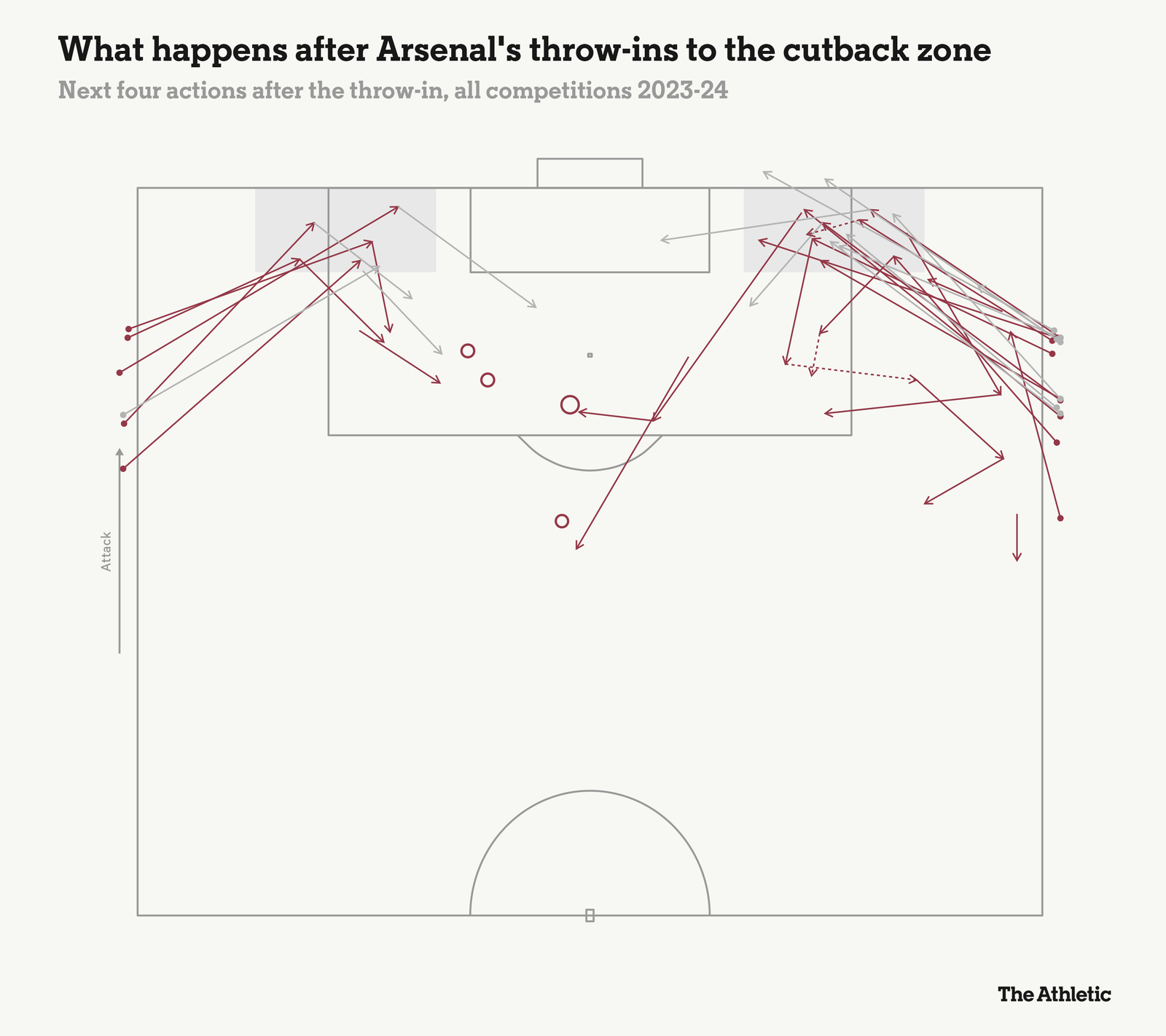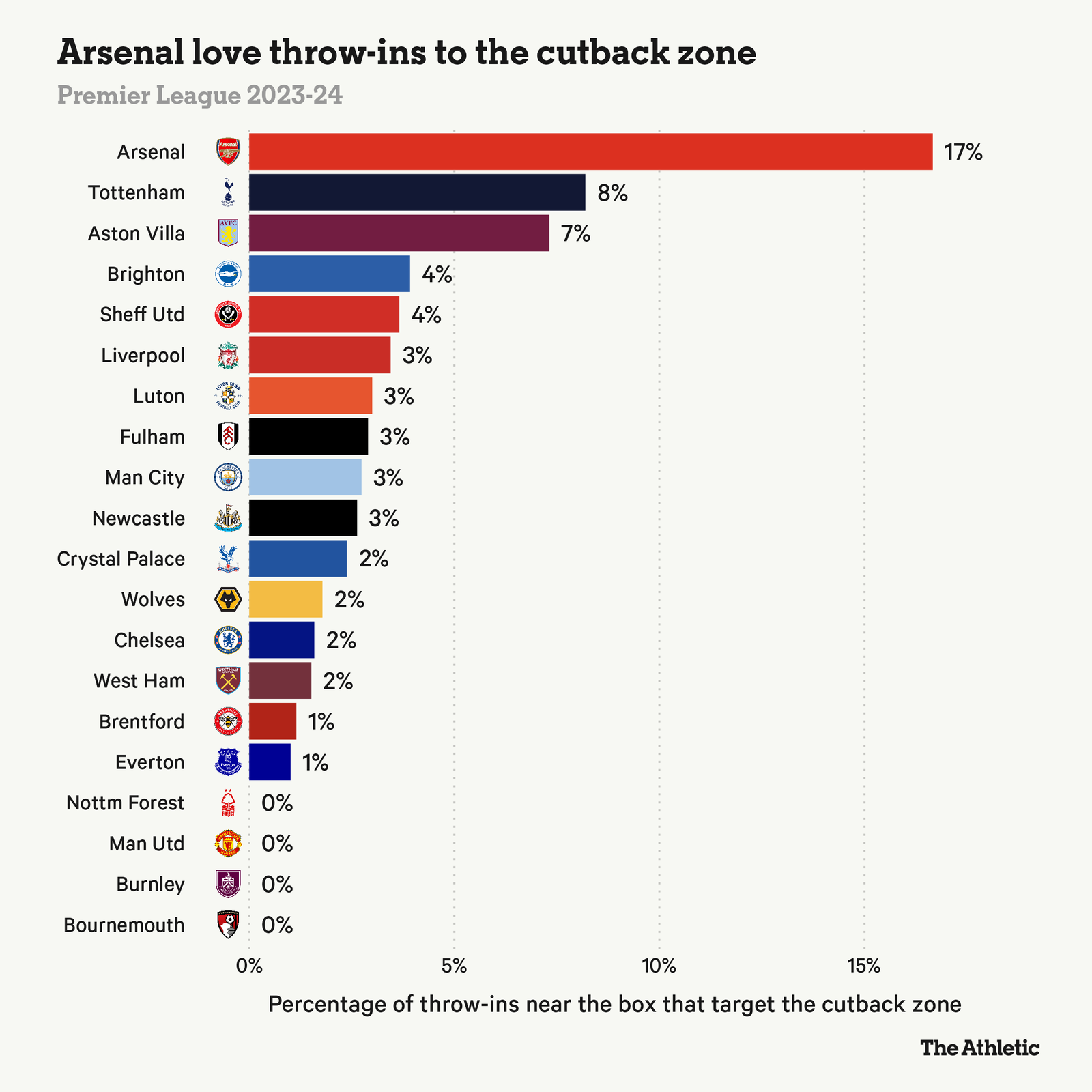In their recent FA Cup match against Liverpool, Arsenal pulled off a clever little throw-in pattern that you don’t see very often from other teams. Then they did it again. And again. Lately this particular throw-in is becoming one of the club’s signature plays.
The basic idea is to get a runner in motion along the goal line, starting near the corner flag and moving away from the thrower toward the penalty area. As the runner slips behind the deepest defender, his team-mate lobs the throw-in over the defender’s head, aiming to hit the runner in stride somewhere near where the goal line and 18-yard box meet.
There are a couple of key concepts at work here. One is that you can’t be offside from a throw-in. This means the runner can stay as deep as possible, making sure his would-be marker can’t watch him and the ball at the same time.
The other thing is that the runner receives the ball in the cutback zone, with a full view of the pitch, in prime position to send a dangerous pass back toward the penalty spot. As defenders rush deeper to protect the goal, the cutback travels the other way, toward an attacker arriving unmarked on their blind side.

Normally a player receiving a throw-in needs time and space to bring the ball under control, but on this play that’s not a problem: Arsenal’s goal-line runners can redirect the lob toward the nearest team-mate with one touch, hitting it on the volley or with their head.
Given all the theoretical advantages of a throw into the cutback zone, it’s a little surprising that nobody tries it nearly as often as Arsenal.
Across all competitions this season, Mikel Arteta’s team have targeted the cutback zone with 17 per cent of their throw-ins taken around the opponent’s penalty area. That’s more than double anyone else in the Premier League, La Liga or the Championship (where Tottenham, Sevilla and Southampton have targeted the cutback zone with eight per cent of their throw-ins near the box).

It may not be a coincidence that other teams that have led the Premier League in cutback throws in recent years are known as tactical innovators with some of the world’s best data operations: Brighton, Brentford and Liverpool. The latter two have even brought in a specialist throw-in coach, Thomas Gronnemark, to work on their sideline tactics.
Gronnemark doesn’t believe in treating throw-ins like corners or free kicks, in which you can train a few simplistic routines and run them over and over, targeting the same player each time. In his view, a throw-in is more like a basketball offence, in which the team with the ball has time to run a series of rotations to create and exploit different spaces, giving the passer multiple reads to choose from.
“The magic for me in throw-ins is that yes, (the cutback throw) could be a potential good option if it’s there,” Gronnemark says, “but if you’re only looking for that, it’s quite easy to mark.”
Arsenal have a variety of ways to set up cutback throws. In their first attempt against Liverpool in the FA Cup, Bukayo Saka ran into the box while Kai Havertz made an opposite movement toward the ball, drawing the defence’s attention and creating space for Martin Odegaard, the goal-line runner, to slip behind him:


Thirty seconds later, they did it again from the same spot, but this time it was a sort of spiral rotation with Saka near the corner flag that put Odegaard into space for the cutback:


Late in the game, Arsenal took a fast throw-in to create a simple one-man cutback pattern on what NFL fans would recognise as a fade route:


The thing all three examples have in common is a momentary defensive lapse caused by a poor zonal structure. “One defender gets isolated, and then that man has to mark maybe 12 or 15 metres in front of him and behind him,” Gronnemark points out. “That’s almost an impossible task to do.”
When a player is trying to defend that much space in two directions, it’s hard not to have blind spots. “We have a lot of focus on scanning when you’re receiving a pass as an attacking player, but it’s just as important to scan when you are defending,” says Gronnemark. The cutback throw works best when a movement toward the ball distracts the defender and he forgets to check on the goal-line runner behind him.
Sometimes you’ll catch Arsenal using legally dubious corner-kick-style screens to create space for a goal-line runner, the way Odegaard did for Gabriel Jesus against Manchester City:

But the physical play can go both ways. Part of a cutback throw’s ancillary threat is that a defender scrambling to defend a throw behind him might crash into the runner, which is how Gabriel Martinelli drew a penalty against Lens in the Champions League:
Even if you set aside penalties, cutback throws are highly effective at creating chances. Since 2018-19, Premier League teams taking a throw-in around the box have scored a non-penalty goal in the next 30 seconds 67 per cent more often when they aim for the cutback zone than when they throw somewhere else. (Consider this one more argument for throwing the damn ball in the box.)
It’s a small but real edge that Arsenal are determined to take full advantage of — and so far nobody seems quite sure how to stop them.
(Top Photo: Stuart MacFarlane/Arsenal FC via Getty Images)
Read the full article here


